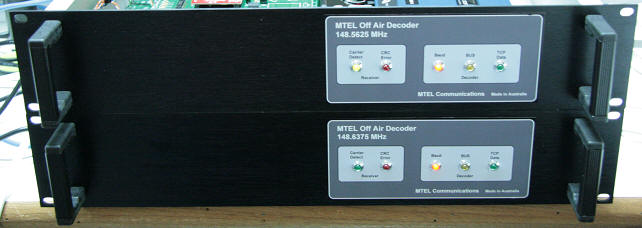The OAD
MKII is a second generation MTEL device which replaced the original 1997
MTEL unit. It is a self contained 2 RU 19inch rack mounted system.
The unit
is a collection of common modules used in other MTEL products. The decoder
is a hand built device as there are no generic decoders with this level of
reliability demanded of this application. The radio receiver, processor and
TCP server are mounted in the rack. Requiring just 240 volts and an antenna
connection the unit will operate down to -110dbm. The receiver operates on
the Hutchison 860MHz broadcast link frequency.
The received audio is FSK
and requires demodulating into a digital data stream. The digital data
stream is then bit and word synchronized
by a 87C51 processor. The output is fed into a ZWorld RCM3200 series
processor which buffers the 87C51 data stream and decodes it into ASCII
message packets. The RCM3200 also provides the TCP socket which acts as a
server.
The OAD
MKII is a standalone device and does not require user interaction. The TCP
address may require setting up initially however after that the device begins
decoding immediately after power up.
There are lights on the front of
the device to indicate its operational state. The descriptions for LEDs from
left to right on the front panel are given below;

This LED
indicates the presence of in-band signal from the receiver. If the level of
signal is good this indication is very accurate. In a noisy signal the LED
may flash during absence of carrier. In this case the signal should be
increased for best operation. Normally this would indicate a poor signal
from the antenna or cable.
The data
stream contains CRC information for each 32 bits of data. If the data is corrupted the CRC LED will
be on for the duration of the corruption. A Piezo will also sound whenever
the LED is ON.
If the
CRC indication activates it will usually be a result of lack of signal on
the broadcast link or it may indicate interference on the link receiver.
This LED
has three states. When there is no signal it will flash at about 5Hertz,
indicating it is searching the data stream for
valid synchronisation data.
ON
indicates the processor has locked onto a valid high data rate paging
transmission (1200 baud). OFF indicates the processor has locked onto a valid low data
rate paging transmission (512).
The LED
will remain in this state until the data stream ceases.
This LED
reflects the data
stream from the 87C51 decoder to the RCM3200 module. It flashes when there
is a valid POCSAG stream. Each flash is 32 bits of data.
The
message packets are sent by TCP to PagerDEC. This LED will flash when 80
bytes of data are sent by the TCP server to the TCP client.
If the socket is not
connected this LED will not flash on the F1 unit. On the F2 unit it will
flash when data is sent to the WBB modem.

